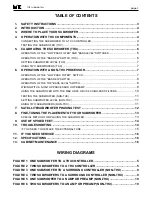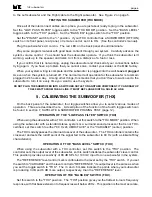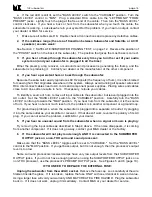
page 14
THX subwoofers
Buzzes and rattles can be cured or improved by applying glue, tape, or pads in the area where the
objects are vibrating against each other. Try felt pads between objects that cannot be taped or glued
together (such as picture frames buzzing against walls).
One subwoofer is sufficient in a stereo system because the human ear-brain hearing system cannot
ocate the direction of bass sounds below 150 Hz. We perceive the direction of low frequency sounds
by the higher frequency overtones reproduced by the Satellite or L/C/R speakers. All M&K Powered
Subwoofers have exceptionally sharp (36 dB/octave) low-pass filters to remove these unwanted
midbass and midrange frequencies, making your M&K subwoofer
truly non-directional.
We realize that you are probably won't design your room around the subwoofer. These suggestions
are intended to be guidelines. Remember that the subwoofer will work in many room locations. These
suggestions are intended to help you find a good balance between sound quality and aesthetics.
9. USE OF SPIKED FEET
We have enclosed a hardware kit consisting of four black metal spikes, threaded at one end and
tapering to a sharp point at the other. Depending on their orientation, they can be used either as
carpet spikes or rubber feet. To avoid damage to the floor, do not use the spiked end on hardwood
or tile floors.
By mounting these spikes into the threaded inserts mounted in the bottom of the subwoofer, you
can elevate the subwoofer, and on carpet couple it more tightly to the floor.
The threaded inserts are found in the four corners of the cabinet's bottom. The inserts are 1/4 -
20, that is, 1/4 inch in diameter and 20 threads per inch. This is compatible with the majority of
alternative spikes, "cones," "tip-toes," etc. offered by other manufacturers.
To properly secure the feet to the cabinet, you must use the provided washer and jamb nut on the
threaded portion of the foot. The washer goes first, with the nut over it, holding the washer securely
in place. This prevents damage to the spike and insert in case something pushes the cabinet laterally.
10. TROUBLESHOOTING
Your subwoofer amplifier circuit provides high reliability, and, if necessary, easy modular parts
replacement. This guide will help solve or diagnose most problems that may occur. Remember, if
a fuse blows, you must replace it with the correct value to avoid fire hazards and to maintain the
warranty.
1. If your subwoofer has no output:
a.
Make sure that the subwoofer is plugged into an AC outlet.
b.
Check the red LED on the subwoofer's back panel. If the LED is not lit, check the AC fuse next
to the LED. Unplug the subwoofer before changing the fuse. See instructions on Page 15. If
the element inside the fuse is broken, replace the fuse. If the fuse blows again, contact your dealer
or M&K.
c.
If the "BASS LEVEL" switch is set to "VARIABLE", make sure that the "BASS LEVEL" control
is set above the "MIN" position. Rotate it clockwise if it is set to the "MIN" position. Make sure that
the SUBWOOFER OUTPUT level control on your processor or amp is set above the "MIN" position.
d.
If the "BASS LEVEL" control is set to "THX", make sure that any SUBWOOFER OFF/ON switch
(found on the controller front or rear panel or remote control) is set to ON. Make sure that the
SUBWOOFER OUTPUT level control on your THX controller is set above the "MIN" position.


































